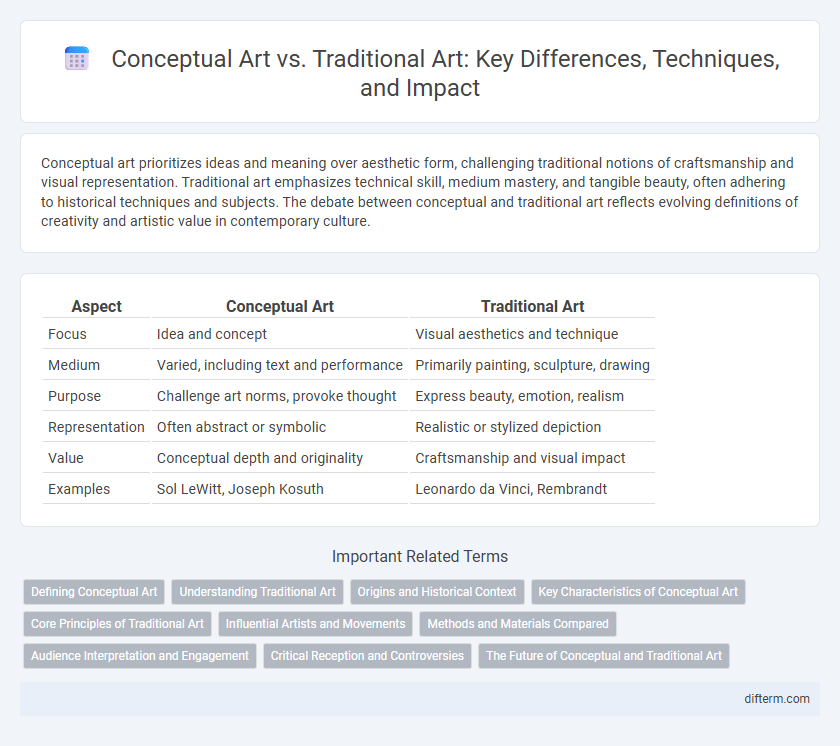Conceptual art prioritizes ideas and meaning over aesthetic form, challenging traditional notions of craftsmanship and visual representation. Traditional art emphasizes technical skill, medium mastery, and tangible beauty, often adhering to historical techniques and subjects. The debate between conceptual and traditional art reflects evolving definitions of creativity and artistic value in contemporary culture.
Table of Comparison
| Aspect | Conceptual Art | Traditional Art |
|---|---|---|
| Focus | Idea and concept | Visual aesthetics and technique |
| Medium | Varied, including text and performance | Primarily painting, sculpture, drawing |
| Purpose | Challenge art norms, provoke thought | Express beauty, emotion, realism |
| Representation | Often abstract or symbolic | Realistic or stylized depiction |
| Value | Conceptual depth and originality | Craftsmanship and visual impact |
| Examples | Sol LeWitt, Joseph Kosuth | Leonardo da Vinci, Rembrandt |
Defining Conceptual Art
Conceptual art prioritizes ideas over aesthetic or material aspects, emphasizing the intellectual engagement of the viewer rather than the visual product. It challenges traditional boundaries by focusing on the concept as the artwork itself, often using language, documentation, and performance as primary mediums. This movement redefines creativity by valuing thought processes and theoretical frameworks, contrasting sharply with traditional art's emphasis on technique and craftsmanship.
Understanding Traditional Art
Traditional art encompasses painting, sculpture, and drawing techniques that have been refined over centuries, emphasizing mastery of materials like oil, charcoal, and clay. Its value lies in tangible craftsmanship, adherence to historical styles, and cultural storytelling grounded in representational forms. Understanding traditional art involves appreciating these technical skills and the cultural context that shapes its visual language.
Origins and Historical Context
Conceptual art originated in the 1960s as a reaction against traditional art forms, emphasizing ideas over aesthetic objects and challenging the conventional focus on craftsmanship and materiality. Traditional art, rooted in centuries-old practices, prioritizes skillful representation and tangible mediums like painting and sculpture, reflecting cultural and historical narratives. The shift from traditional to conceptual art marks a significant transformation in the art world, highlighting changing perspectives on the purpose and definition of art.
Key Characteristics of Conceptual Art
Conceptual art prioritizes ideas and concepts over aesthetic qualities or material forms, emphasizing the intellectual engagement of the viewer. It often employs text, instructions, or performance rather than traditional painting or sculpture, challenging conventional definitions of art. Key characteristics include a focus on process and meaning, dematerialization of the art object, and the use of language as a medium.
Core Principles of Traditional Art
Traditional art emphasizes mastery of foundational techniques such as drawing, painting, and sculpting, prioritizing accurate representation and craftsmanship. Core principles include composition, perspective, color theory, and anatomy, which guide artists in creating realistic and balanced works. This art form often values historical continuity and the transmission of skills across generations, reinforcing established aesthetic standards.
Influential Artists and Movements
Conceptual art, championed by artists like Sol LeWitt and Joseph Kosuth, emphasizes ideas over aesthetic form, marking a significant departure from traditional movements dominated by figures such as Leonardo da Vinci and Rembrandt, who focused on technical skill and representation. The conceptual movement, rooted in the 1960s, challenges materiality and embraces multimedia, contrasting with the classical techniques and mediums like oil painting prevalent in traditional art. These divergent approaches have shaped contemporary artistic discourse, influencing movements like Minimalism and Abstract Expressionism, which bridge the conceptual and traditional paradigms.
Methods and Materials Compared
Conceptual art prioritizes ideas over physical materials, often utilizing unconventional methods like text, performance, or found objects to challenge traditional aesthetics. Traditional art relies on well-established techniques such as oil painting, sculpture, and drawing, emphasizing craftsmanship and materiality. This contrast highlights a shift from tangible mediums to ephemeral, concept-driven expressions, transforming the artist's role from maker to thinker.
Audience Interpretation and Engagement
Conceptual art prioritizes audience interpretation by emphasizing ideas over aesthetic form, encouraging viewers to engage intellectually with the work's meaning. Traditional art relies on visual techniques and craftsmanship to evoke emotional responses, guiding the audience through recognizable symbols and narratives. This contrast shapes how viewers actively construct meaning in conceptual pieces versus passively appreciating the sensory experience in traditional artworks.
Critical Reception and Controversies
Conceptual art often faces critical scrutiny for prioritizing ideas over aesthetics, challenging traditional notions of craftsmanship celebrated in classical art forms. Traditional art is praised for technical skill and visual appeal but sometimes criticized for lacking innovative conceptual depth prevalent in contemporary discourse. Controversies arise around conceptual works' perceived ambiguity and elitism, contrasting with debates on traditional art's resistance to modern social and political narratives.
The Future of Conceptual and Traditional Art
Conceptual art emphasizes ideas and social commentary over aesthetic form, predicting a future where digital and interactive mediums dominate artistic expression. Traditional art, rooted in techniques like painting and sculpture, will continue evolving through technological integration, preserving craftsmanship while embracing innovation. The convergence of these approaches suggests a dynamic art landscape where meaning and materiality coexist and inspire new creative possibilities.
Conceptual vs Traditional Infographic

 difterm.com
difterm.com